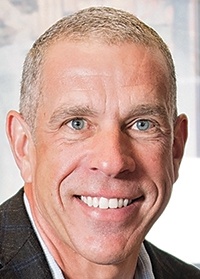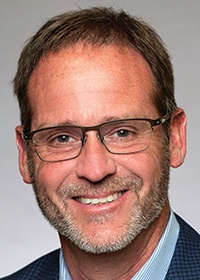Community bankers working to protect their customers and their own bottom lines
by April 14, 2020 12:32 pm 1,881 views

Landon Taylor, president and chief operating officer of First Western Bank.
Like many banks, the balance sheet the past couple of years has looked good for First Western Bank, an 11-branch lender headquartered in Booneville, with about $462 million in assets. The company reported a net income of $3.5 million last year, according to the Federal Deposit Insurance Corp. (FDIC), up from $2.9 million in 2018 and $2 million in 2017.
First Western is celebrating its 110th anniversary in April. President and chief operating officer Landon Taylor said across most ratios, 2019 was the best year in the company’s history.
“We look as good as we’ve ever looked [at the end of 2019],” said Taylor, a First Western banker since 2006, based in Northwest Arkansas.
Projections for 2020 to build on that momentum have changed because of the COVID-19 (coronavirus) pandemic, and not just for First Western. All community banks now face a new challenge — using technology and taking safety measures to continue to serve customers but also offering as much help to borrowers and small businesses that are experiencing or expect to experience cash flow problems this year. Those remedies include a variety of forbearance measures, rate modifications and loan modifications.
If the health emergency goes on for a long time, though, those approaches could potentially affect every bank’s bottom line.
“The reality is that we are a small business, too. We just happen to be providing financial services,” Taylor said. “We understand that everybody wants to mitigate costs and improve margins. We want to do the same.”
Taylor and other bank industry leaders who spoke with the Northwest Arkansas Business Journal said they had heard steadily from customers since mid-March when the World Health Organization declared COVID-19 a global pandemic. The U.S. economy started to react negatively.
“There’s a great amount of pressure there,” Taylor said. “The unknown is what’s scaring everyone. They don’t know if this is something that wraps up at the end of April or if we’re talking about August.”
Banks are critical partners to most any business. In the historical age of COVID-19 — and the paralyzing financial fallout caused by it — that relationship has likely never been so meaningful.
Taylor said there is an overwhelming sense among lenders at all banks to help them — and do it promptly.
“I’m fortunate that I’ve been in business long enough that the banking community, as a whole, is pretty small,” Taylor said. “The circles are pretty small, especially in Northwest Arkansas. I took it upon myself early on to reach out to some of my peers at other banks to share ideas and make sure we are all thinking along the same lines.
“It’s no longer about rates and agendas. All of us are trying to make good decisions to protect our most valuable resources: our employees, facilities and customers. Everybody has the same goal. Whether it’s Signature Bank or United or Generations or Chambers, we did not hoard ideas. We’ve shared them openly.”
PATIENCE WITH PPP
Taylor said Arkansas’ banks entered the pandemic from a position of strength and are well-equipped to help their communities.
There were 87 bank institutions in Arkansas as of Dec. 31, 2019, according to the FDIC. The assets of all Arkansas banks as of Dec. 31 were $112.86 billion. The industry also employs 27,000 people in the state, according to the Arkansas Bankers Association (ABA).
Banks around the country will play a significant role in helping small businesses get cash quickly from the federal stimulus package.
Under the $2.2 trillion relief package intended to rescue U.S. commerce and signed into law by President Donald Trump, the Small Business Administration’s Paycheck Protection Program (PPP) will offer $350 billion in loans through banks and credit unions to cash-strapped businesses employing under 500 people. Banks started to receive applications for those loans on April 3.
The size of the loan is based on a company’s average monthly payroll for the past year, with a $10 million cap for any one loan. Most of the funds — 75% — must be used for eight weeks’ worth of payroll. The rest can be used for rent, mortgage interest or utilities. If at least 75% of that loan is used for payroll, the entire loan will be forgiven.

Jon Harrell, chairman of Generations Bank in Rogers, said understanding the mechanics and sheer volume of the loan program took some study. But a lot is riding on its implementation.
He said the bank’s approach to carrying out the PPP loan process had been all hands on deck because of the urgency and massive demand for the federal assistance.
“We want to make sure we can facilitate quickly,” he said. “A lot of [businesses] are a little desperate, and there’s panic there, with the thought being this [money] could run out. There’s an urgency that they want us to take care of it as quickly as we can, and that is what we intend to do.”
Harrell echoed Taylor’s focus on taking care of bank staff first and foremost. He said Generations hasn’t laid off employees and doesn’t plan to. The company also paid its non-executive employees —100 counting full- and part-time workers — a one-time bonus. Harrell said the money is to help with personal expenses, including child care, and to help provide “peace of mind” during an uncertain and stressful time.
With employees taken care of, Harrell said customers, of course, come next.
“If we forego income this year, we just do,” he said. “We realize we probably will not meet our growth goals in our income budget. I think we have the ownership and management and shareholder base that understands that. We want to do as well as we can, but our priorities are our people and our customers.”
Each PPP loan will offer lenders 100 basis points, or 1% rate. In its final guidance, the Small Business Administration raised the amount from 50 basis points. That increase, Taylor said, is significant.
“Our loan portfolio is about $385 million,” he said. “We couldn’t start putting 10% of our portfolio on the books at [0.05%].
Harrell said Generations Bank — which has nine brick-and-mortar locations in Arkansas, including four in Northwest Arkansas and the Fort Smith metro — is adding additional money into loan loss reserves.

“You prepare for the worst, but you expect the best,” Harrell said.
Brian Glenn, president of Bank of Gravette, said the company is offering a couple of options for its customers who say cash flow might be tight for a while, with very few questions asked. The four-branch bank is offering deferred payments for 90 days or interest-only payments for six months.
He said customers he has spoken with welcome the opportunity for short-term capital offered through the PPP loan, to either bring back employees they have already laid off or keep workers they have on staff.
“We want customers to know upfront that this money has [a]particular use in its purpose and has to be used [a certain] way,” he said. “I think there’s a benefit to it. Especially being in the middle of the country like we are. If we feel at the end of April that we have a real shot to come out of this thing and we can lessen our social distancing requirements, absolutely it’s a benefit.
“If we have to go another round or two, I start having concerns about the national effect of it all. Somebody’s going to have to pay for debt forgiveness. There’s no such thing as getting something for free.”
ADDITIONAL CHALLENGES
Not all of the challenges bankers face these days are related purely to finance.
Social distancing guidelines — and in some cases mandates — are keeping people at home and away from other people. Banks have closed their lobbies and shortened business hours. They are primarily conducting business with enhanced drive-up access, mobile banking and appointments.
That’s forced bankers to confront a new reality — how to maintain a certain level of customer service and in-person interaction, which is a quality of community bankers, without compromising the necessary health controls.
Rob Robinson, chairman of the Arkansas Bankers Association, said the balance had taken a period of adjustment, but bankers are probably more connected to customers than ever before.
“We’re certainly utilizing a variety of platforms right now to stay in touch [with customers],” said Robinson, who is El Dorado market president of Pine Bluff-based Simmons Bank.
Harrell said banks that have made significant technology investments to enhance their customer service efforts are now seeing a healthy return. Navigating the PPP loan process mainly through digital channels, though, also shows the importance of dealing with people.
“If you call a 1-800 number at Bank of America, how quick are you going to get through to somebody to talk you through it?” he wondered. “It may be easier than I think, but most people want to call ‘their’ banker. Someone they know. I think this [PPP] piece really shows the need for relationship banking.”
Glenn said the pandemic might offer an opportunity to rethink the oft-discussed banking business model debate — brick-and-mortar versus online.
“As it relates to hours, maybe get back to an 8-to-5 [day] as opposed to 7:30-to-6,” he said. “That one little change makes a big difference in our staffing model.”
In general, Glenn said there are likely some additional tweaks to be considered to staffing and overhead costs, once a certain level of normalcy returns to the world.
